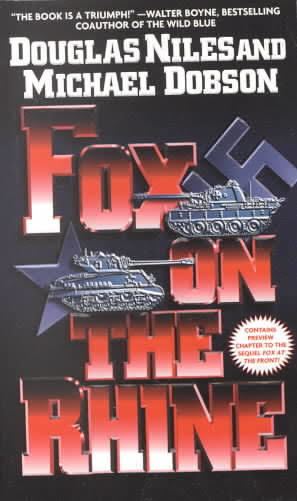7.8 /10 1 Votes7.8
Cover artist Tony Greco Media type Print ISBN 0-8125-7466-4 Country United States of America | 3.9/5 Goodreads Language English Pages 546 pp Originally published June 2000 | |||||||||||||||||||||||||||||||||
 | ||||||||||||||||||||||||||||||||||
Publication date June 2000 (hardbound)June 2002 (paperback) Similar Michael Dobson books, Alternate history books, Other books | ||||||||||||||||||||||||||||||||||
Fox on the Rhine is a 2000 alternate history novel written by Douglas Niles and Michael Dobson. It details a course of events over late 1944 that resulted from Adolf Hitler's death in the July 20 plot and Field-Marshal Erwin Rommel's survival of the crackdown.
Contents
Plot summary
The book begins on July 20, 1944, when Colonel Claus von Stauffenberg successfully bombs the Wolfsschanze during a strategy conference and later executes Operation Valkyrie in Berlin. However, his decision to signal Hitler's death to other conspirators by code buys enough time for SS chief Heinrich Himmler to launch his own countercoup called Operation Reichssturm. While the Allies are working to break out of Normandy through Operation Cobra, Field-Marshal Erwin Rommel recovers from the injuries he suffered during a real-life strafing run three days before the Stauffenberg coup. Himmler appoints him as commander of all German forces in Western Europe, under watch from the SS, after Field Marshal Günther von Kluge dies in an air attack. He also believes that Carl-Heinrich von Stülpnagel's mention of Rommel as a possible Bomb Plot conspirator holds no weight.
Back in Berlin, Himmler takes charge of the German government and sends Foreign Minister Joachim von Ribbentrop and Wehrmacht Colonel Gunther von Reinhardt to negotiate a peace treaty with the Soviet Union. The plan, called Operation Carousel, calls for Germany to shift troops from the Eastern Front to the west, while leaving Eastern Europe and Scandinavia to the Soviets. The Nazis will also share missile technology with Moscow. The sudden implementation of the treaty angers the Allies, who promptly shift naval forces from the Pacific to the European Theater of Operations. At the same time, Rommel organizes a counterattack at Abbeville against the US 19th Armored Division using units recovered from the Normandy front. He also orders the 19th Army to evacuate southern France ahead of Operation Dragoon and regroup at the Westwall.
Having identified all of the surviving July 20 conspirators, Himmler orders the SS to kill them, in some instances posing as British Commandos. Luftwaffe general Adolf Galland is assigned to spearhead the development of the Me-262 fighter. Because of his concern for the troops, Rommel disagrees with Himmler about holding Metz as a strongpoint against the Allies. Himmler responds by sending SS troopers disguised as US soldiers to ambush a combat unit Rommel withdraws from the city.
Galland's efforts with the fighter program results in the mobilization of all surviving Luftwaffe units in a co-ordinated assault against an Allied bomber raid of almost 2,600 aircraft in November 1944. The attack severely cripples the bomber force, so much that the Allies are forced to suspend the bombing campaign. The postponement buys Rommel more time to boost his forces for a major offensive through the Ardennes. Although the operation is codenamed Wacht Am Rhein, von Reinhardt successfully proposes a change to Fuchs Am Rhein (Fox on the Rhine) to emphasize Rommel's role as the leader of the offensive. Heinz Guderian is also assigned to lead one of the two panzerarmees to be used in the operation, which aims to reach Antwerp.
Like the real-life Battle of the Bulge, the operation begins on the night of December 16, 1944. The capture of a major fuel dump at Stavelot allows the German forces to extend their advance much further than in the actual offensive, capturing a bridge in Dinant to keep the momentum going. Field Marshal Montgomery, who successfully reinforced 21st Army Group's side of the Meuse River against a German crossing, dies when German forces bombard his command post at Waterloo. The Germans also conquer Bastogne.
Third Army commander General George Patton assigns the 19th Armored Division to counterattack against the Germans at Dinant and to destroy the bridges. The sudden appearance of the US forces prompts Rommel to send one division that has already crossed back to Dinant and hold it with the Panzer Lehr division coming from the east. However, the Allies launch heavy air attacks against the Germans. The 19th Armored Division breaks through and destroys the bridges on December 26. Left without any option to refuel all Wehrmacht units that have crossed the Meuse, Rommel decides to surrender Army Group B to Patton. An SS general tries to kill Rommel as he prepares to meet Patton, but one of the field marshal's assistants stops the assassin in time. Himmler sees the surrender as an opening for the SS to consolidate their grip on all surviving Wehrmacht units while Joseph Stalin is pleased with the opportunity for a new attack now that the Eastern Front is almost clear of German forces.
Subplots
Other subplots in Fox on the Rhine include the adventures of a US B-24 Liberator aircrew (explained through a crewmember's letters to his mother), a German-American US Army officer doing intelligence work, a Panther tank commander who eventually becomes Rommel's personal driver, an Associated Press reporter yearning for a position as field correspondent, and some officers in the US 19th Armored Division's Combat Command A. A more general explanation of the story (and other in-universe events) is written in the novel through excerpts from a fictional history book called War's Final Fury by Professor Jared Gruenwald.
Historical Characters
Germans:
Allies:
Soviets:
